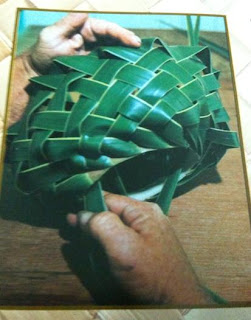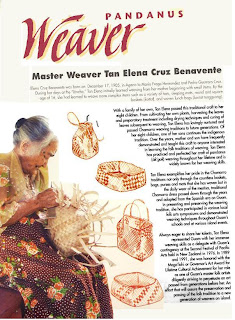I just submitted my VERY ROUGH DRAFT to Don, so that I may get immediate feedback from him on whether I'm moving in the right direction. If not, I will edit my paper accordingly. Considering that I am an ESL teacher, I titled my research paper, Toward the Development of a Mathematics Curriculum Using Coconut Weaving to Increase the Mathematics Schema and Skills of English Language Learners in Guam.
I've included my references for my research paper below, and if they may be of use to you, then that's great. In particular, these resources may be more relevant for my fellow Guam MACIMISERS, since the focus of the references pertain to the island of Guam. I wish you all the best of luck in your research!
Anderson, R. C. (2004). Role of the reader’s schema in comprehension, learning, and memory. In R. B. Ruddell, & N. J. Unrau (Eds.), Theoretical models and processes of reading (5th ed.) (pp. 594-606). Newark, DE: International Reading Association.
Anderson, T.J. (2010). Weaving, Retrieved March 9, 2010 from http://guampedia.com/weaving
Bamba, J. Personal INTERVIEW. 14 March 2010.
Bransford, J. D. (2004). Schema activation and schema acquisition: Comments on
Richard C. Anderson’s remarks. In R. B. Ruddell, & N. J. Unrau (Eds.),
Theoretical models and processes of reading (5th ed.) (pp. 607-619). Newark,
DE: International Reading Association, Inc.
Carrell, P.L., Devine, J. and Eskey, D.E. (1988). Interactive Approaches to Second Language Reading. Cambridge: CUP.
Carrell, P. & Eisterhold, J. (1988). Schema theory and ESL reading pedagogy. In P. Carrell, J. Devine, & D. Eskey (Eds.), Interactive Approaches to Second Language Reading (pp. 73-92). Cambridge: Cambridge University Press.
Cruz, J.A. Personal INTERVIEW. 12 March 2010.
Cruz, J.Q. Personal INTERVIEW. 12 March 2010.
Cunningham, L. (1992). Ancient Chamorro Society. Honolulu, HI: Bess Press.
Cunningham, L. (2001). Guam, A Natural History. Honolulu, HI: Bess Presss.
Cunningham, L and Beaty, J. (2001). Guam, A Natural History. Honolulu, HI: The Bess Press.
Cunningham, L., Beaty, J. and Perez, R. (2001). A History of Guam. Honolulu, HI: Bess Press.
Dunford, B. and Ridgell, R. (2006). Pacific Neighbors, The Islands of Micronesia, Melanesia, and Polynesia. Hawaii: Bess Press.
Farrell, D. (1981). The Pictorial History of Guam, Guam: 1898-1918. Tamuning, GU: Micronesian Productions.
Farrell, D. (1986). The Pictorial History of Guam, THE AMERICANIZATION 1898-1918. Tamuning, GU: Micronesian Productions.
Farrell, D. (1991). The Pictorial History of Guam, THE SACRIFICE 1919-1943. San Jose, TINIAN: Micronesian Productions.
Grabe, W. (1988). Reassessing the Term Interactive. In Carrel, P.L., Devine, J. and Eskey, D.E. (1988). Interactive Approaches to Second Language Reading. Cambridge: CUP.
Guamology.org.
http://www.guamology.org/Guampedia.
http://www.guampedia.com/Guam Public School System Annual State of Public Education Report, School Year 2007-2008, October 30, 2008.
Guam Public School System Annual State of Public Education Report, School Year 2006-2007, October 30, 2007.
Guam Visitors Bureau (2010). Our Culture. Retrieved March 15, 2010 from
http://www.visitguam.org/Runtime/Culture.aspxLaguana, R. Personal INTERVIEW. 15 March 2010.
Lloyd, C.V. (1996). How teachers teach reading comprehension: an examination of four categories of reading comprehension instruction. Reading Research and Instruction, 35: 170-84.
Naputi, J.S. Personal INTERVIEW. 6 February 2010.
Naputi, J.S. Personal INTERVIEW. 23 February 2010.
Naputi, J. N. Personal INTERVIEW. 23 February 2010.
Ohler, J. (2006). The World of Digital Storytelling. Educational Leadership, 63 (4): 44-47.
Oliver, D. (1989). The Pacific Islands. Honolulu, HI: University of Hawaii Press.
Paulino, F. (2010). Weaving. Retrieved march 9, 2010 from
http://www.pacificworlds.com/guam/stories/story3.cfmPolitical Status Education Coordinating Commission (1993). Hale’-ta, Hestorian Taotao Tano’, HISTORY OF THE CHAMORRO PEOPLE. Agana, GU.
Political Status Education Coordinating Commission (1994). Hale’-ta, I MA GOBETNA-ÑA GUAM, Governing Guam: Before and After the Wars. Agana, GU.
Ridgell, R. PACIFIC NATIONS AND TERRITORIES, The Islands of Micronesia, Melanesia, and Polynesia. Honolulu, HI: Bess Press.
Sanchez, P. (1988). Guahan GUAM: The History of Our Island. Agana, GU: Sanchez Publishing House.
The Culture of Guam. Retrieved March 12, 2010 from
http://ns.gov.gu/culture.htmlThe Palms Press. Hafa Adai Guam, USA 1988-1989, A VISIT TO THE VILLAGES.
Zabel, M.K. (1991). Storytelling, Myths, and Folk Tales: Strategies for Multicultural Inclusion. Preventing School Failure, 36 (1), 32-34.

































